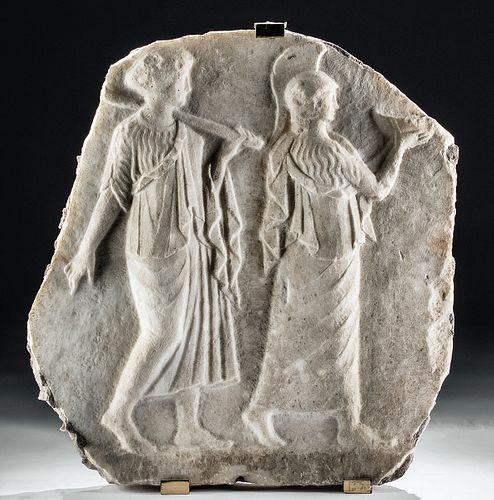Roman Marble Relief of Minerva & Arachne, Art Loss Cert
Lot 52
About Seller
Artemis Gallery
686 S Taylor Ave, Ste 106
Louisville, CO 80027
United States
Selling antiquities, ancient and ethnographic art online since 1993, Artemis Gallery specializes in Classical Antiquities (Egyptian, Greek, Roman, Near Eastern), Asian, Pre-Columbian, African / Tribal / Oceanographic art. Our extensive inventory includes pottery, stone, metal, wood, glass and textil...Read more
Estimate:
$40,000 - $60,000
Absentee vs Live bid
Two ways to bid:
- Leave a max absentee bid and the platform will bid on your behalf up to your maximum bid during the live auction.
- Bid live during the auction and your bids will be submitted real-time to the auctioneer.
Bid Increments
| Price | Bid Increment |
|---|---|
| $0 | $25 |
| $300 | $50 |
| $1,000 | $100 |
| $2,000 | $250 |
| $5,000 | $500 |
| $10,000 | $1,000 |
| $20,000 | $2,500 |
| $50,000 | $5,000 |
| $100,000 | $10,000 |
| $200,000 | $20,000 |
About Auction
By Artemis Gallery
Feb 13, 2020
Set Reminder
2020-02-13 10:00:00
2020-02-13 10:00:00
America/New_York
Bidsquare
Bidsquare : Exceptional Antiquities, Asian, Ethnographic
https://www.bidsquare.com/auctions/artemis-gallery/exceptional-antiquities-asian-ethnographic-4848
An important one-day auction featuring museum-worthy examples of Egyptian, Greek, Roman, Etruscan, Near Eastern, Far East / Asian, Pre-Columbian, African / Tribal, Oceanic, Native American, Spanish Colonial, Russian, Fossils, Ancient Jewelry, Fine Art, so much more! Artemis Gallery info@artemisgallery.com
An important one-day auction featuring museum-worthy examples of Egyptian, Greek, Roman, Etruscan, Near Eastern, Far East / Asian, Pre-Columbian, African / Tribal, Oceanic, Native American, Spanish Colonial, Russian, Fossils, Ancient Jewelry, Fine Art, so much more! Artemis Gallery info@artemisgallery.com
- Lot Description
Rome, Imperial Period, ca. 1st to 2nd century CE. A large, evocative marble relief, probably from the side of a sarcophagus or a monument, depicting two women walking in procession - the one leading, the goddess Minerva, holds an offering bowl up in both hands, while the other is possibly Arachne, the talented mortal weaver; this second figure may also be a mourner or the deceased whose monument the relief was made to mark. The women are depicted in profile, each with her body in a dynamic pose with her legs bent. Minerva wears her characteristic plumed helmet and a long himation held in place on her back shoulder over what looks like a fur garment on her upper body. Her face is solemn and expressionless, as if focused on whatever she is holding. Size: 16.5" W x 18.1" H (41.9 cm x 46 cm)
Although Minerva and Arachne are often depicted with the goddess attacking the mortal, as at the massive relief at Rome's Forum Transitorium, this pair suggests a more peaceful outcome. The second woman follows the goddess while holding a weaving shuttle (the tool Minerva used to beat her in Ovid's version of the story) over her back shoulder. She stands a little taller than the goddess, also wearing a himation held in place at her back shoulder; one arm with a wonderfully carved hand extends behind her as she walks, while the other holds the shuttle in an easy manner. Her face, too, is expressionless, her hair depicted up in a curled coiffure, but her posture suggests that she is calm. She appears to be youthful, as Arachne was when she had her weaving contest with Minerva.
In that story, which we know from Book Six of Ovid's "Metamorphoses" (ca. 8 CE) but that is almost certainly a much older tale, Arachne, a young girl from Lydia, clashes with the goddess Minerva over her weaving skill. When Arachne's weaving is flawless, Minerva beats her with her shuttle and Arachne hangs herself in shame. Minerva then takes pity on her and transforms her into a spider, so that she might weave forever. Today, the story is often viewed as a straightforward one about divine punishment for a mortal's hubris, but to the ancient Romans, it would have had different meanings - and they would have been familiar with versions of the story that were not written by Ovid.
Instead, the Romans put Minerva on sarcophagi - what this fragment is likely from - alongside figures of women and children in mourning. Weaving was one of the most important roles that women had in ancient Rome and the woman who this piece memorialized may have been proud of her own skill and wished to be remembered as like Arachne.
This piece is accompanied by a digital Art Loss Register Certificate, reference number S00089023
Provenance: private New York, USA collection; ex-private Swiss collection, acquired during the 1980s
All items legal to buy/sell under U.S. Statute covering cultural patrimony Code 2600, CHAPTER 14, and are guaranteed to be as described or your money back.
A Certificate of Authenticity will accompany all winning bids.
We ship worldwide and handle all shipping in-house for your convenience.
#152812This is a fragment from a larger relief, probably the side of a monument or a sarcophagus. The two women are very well preserved in form and detail, with only the back end of the second woman's attribute lost. The surface is weathered with some pitting and wear commensurate with age. Nice deposits that do not obscure detail.Condition
- Shipping Info
-
All shipping is handled in-house for your convenience. Your invoice from Artemis Gallery will include shipping calculation instructions. If in doubt, please inquire BEFORE bidding for estimated shipping costs for individual items.
-
- Buyer's Premium



 EUR
EUR CAD
CAD AUD
AUD GBP
GBP MXN
MXN HKD
HKD CNY
CNY MYR
MYR SEK
SEK SGD
SGD CHF
CHF THB
THB














